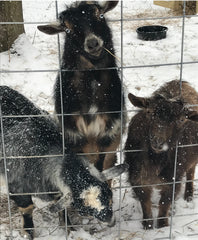
Having recently moved from northeast Ohio to Mid-Missouri, I thought the days of lake effect snow storms were behind us and I was looking forward to a more mild winter season..... No such luck. 2024 has started off with subzero temps and more snow than I care to mention. It's like Missouri heard that the winters along Lake Erie were cold and snowy and said, "Hold my beer!" While my kiddos are loving the multiple snow days, caring for goats during extreme winter weather can be challenging. The good news is, goats are built for cold weather and with a little planning and effort, you can ensure they stay warm and healthy even when the air hurts your face.
SHELTER

It is important that goats can get out of the elements, especially wind and rain. In most cases, a 3 sided structure would be adequate. On our homestead, the female goats are in the main barn. When the temp dips too low or the snow gets too deep, we simply keep them secured inside the barn which is divided into multiple pens. Goats keep warm by bedding down together so with the recent cold snap, we actually combined the girls into fewer pens in order to allow them to huddle together and keep each other warm. Our boys have a run in shelter with 3 1/2 walls ( pictured above) but with the extreme temps coming (lows around -12F and down to -33F with the wind chill) we actually hung up panels made of outdoor canvas to further protect them from the elements. Making sure your goats have adequate shelter is one of the most important factors in protecting them from weather related illness or injury
BEDDING

Along with a roof over their heads, it is equally important that goats have dry, warm bedding to keep them warm. On our farm we use the deep litter method. This is where, instead of cleaning out the soiled bedding from the pens, we simply continue to lay down more clean bedding on top. This allows the bottom layers to begin to compost and release heat. Now, the downside of this is that there is one heck of spring cleaning to be done once the weather warms up. We use straw or leftover hay for bedding but you can also use pine shavings. When the temps begin to drop, make sure you give them plenty of extra bedding to keep them warm.
HYDRATION

Frozen water buckets are my nemesis in the winter. To each his own, but I refuse to use any sort of heated water bowls or the like in our barn. Heat + Hay/Straw = too much anxiety for me. Barn fires can be devastating and, as the daughter of a retired firefighter, having any sort of heating element in the barn would cause me too much anxiety. I would rather carry buckets of hot water from the house to the barn than lay awake at night worried about a fire. Another technique we use is filling plastic bottles with saltwater and floating them in the buckets. The salt will prevent the bottles from freezing and, as the animals drink, the bottles move around and help prevent the bucket from freezing over. There are also various ways to insulate your water buckets which can help prevent ice from forming. Rubber buckets will provide more insulation than plastic ones and they also make insulated wraps for buckets that you can buy from farm supply stores. Some people have success placing their buckets in the middle of a rubber tire for extra insulation. I also make sure that I place the water buckets in the corners of the pen farthest away from the outside walls and doors. Small changes in location can help prevent buckets from icing over.
HAY, HAY, AND MORE HAY

Goats are ruminants and one of the ways they can help keep warm is through digestion. Where humans tend to feel colder after eating, goats have the opposite experience. The fermentation that occurs in their rumen provides an internal heat source for them so it is important for goats to have 24/7 access to hay in colder weather. Nutrition in general is an important aspect for keeping goats healthy and warm in the winter. In addition to having hay available, goats should also have access to loose minerals to ensure that they have healthy coats to keep them warm and strong immune systems to ward off illness.
As we wrap up our guide on keeping goats snug in winter, remember, a warm and content goat is a happy and healthy goat. By providing adequate shelters, warm bedding, ample hydration, and a nutrition-packed diet, you're not just shielding them from the chill – you're fostering their well-being. . Embrace these practices, and you'll not only have warm goats but also a heartwarming connection with these resilient creatures. Here's to a season of comfort, health, and joy for both you and your caprine companions!


How can you protect the goats in the rainy season apart from dry season
Thanx for the tutorials. Quite interesting